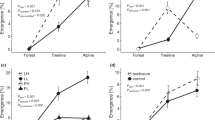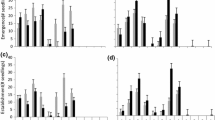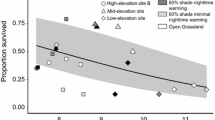Abstract
Thermal control of treeline position is mediated by local environmental and ecological factors, making trends in treeline migration difficult to extrapolate geographically. We investigated the ecological dynamics of conifer establishment at treeline in the Mealy Mountains (Labrador, Canada) and the potential for its expansion with climate warming. Available seedbed and tree seedling emergence in the treeline ecotone were monitored, and seeds and seedlings of Picea mariana were planted along an elevational gradient from open-canopy forest through tree islands to alpine tundra. Experimental treatments included passive warming of daytime air, ground disturbance, and vertebrate herbivore exclosures. Responses in seed germination and seedling growth, damage, and mortality were monitored over two growing seasons, and re-surveyed after 5 years. While no tree seedlings were observed growing naturally above the treeline, planted seeds were able to germinate, develop and overwinter, and persist for 4 years in all habitats examined. Disturbance of the seedbed was important for seedling emergence in the forest and tree islands. While temperature enhancement alone had little impact on emergence, even moderate temperature increases had significantly disproportionate effects on emergence of seedlings in the alpine habitat when combined with soil disturbance, indicating that future climate warming could lead to treeline advance if viable seed and suitable substrate for recruitment are available. The positive effect of excluding herbivores suggests that herbivory may be an important filter modifying future species distribution. While seedbed conditions and herbivory would control the rate of individual species advance, the results indicate potential upslope migration of the treeline in the Mealy Mountains, with consequent loss of alpine ecosystems.





Similar content being viewed by others
References
Arft AM, Walker MD, Gurevitch J, Alatalo JM, Bret-Harte MS, Dale M, Diemer M, Gugerli F, Henry GHR, Jones MH, Hollister RD, Jonsdottir IS, Laine K, Lévesque E, Marion GM, Molau U, Molgaard P, Nordenhall U, Raszhivin V, Robinson CH, Starr G, Stenstrom A, Stenstrom M, Totland O, Turner PL, Walker LJ, Webber PJ, Welker JM, Wookey PA (1999) Responses of tundra plants to experimental warming: meta-analysis of the International Tundra Experiment. Ecol Monogr 69:491–511
Astrup R, Coates KD, Hall E (2009) Recruitment limitations in forests: lessons from an unprecedented mountain pine beetle epidemic. For Ecol Manage 256:1743–1750
Bean D, Henry G, Rolph S (2003) CANTTEX Field Manual Part B—Additional Methods and Experimental Manipulations. EMAN North
Bell T, Jacobs JD, Munier A, Leblanc P, Trant A (2008) Climate change and renewable resources in Labrador: looking toward 2050. In: Proceedings and report of a conference held in Northwest River, Labrador, 11–13 March. Labrador Highlands Research Group, Memorial University of Newfoundland, St. John’s, NL
Cairns DM, Moen J (2004) Herbivory influences tree lines. J Ecol 92:1019–1024
Cairns DM, Lafon C, Moen J, Young A (2007) Influences of animal activity on treeline position and pattern. Phys Geogr 28:419–433
Callaway RM, Walker LR (1997) Competition and facilitation: a synthetic approach to interactions in plant communities. Ecology 78:1958–1965
Castro J, Gomez JM, Garcia D, Zamora R, Hodar JA (1999) Seed predation and dispersal in relict Scots pine forests in southern Spain. Plant Ecol 145:115–123
Chen B, Chao WC, Liu X (2003) Enhanced climatic warming in the Tibetan Plateau due to doubling CO2: a model study. Clim Dyn 20(4):401–413
COSEWIC (2002) Assessment and Update Status Report on the Woodland Caribou Rangifer tarandus caribou in Canada. Committee on the Status of Endangered Wildlife in Canada
Côté M, Ferron J, Gagnon R (2003) Impact of seed and seedling predation by small rodents on early regeneration establishment of black spruce. Can J For Res 33:2362–2371
Côté M, Ferron J, Gagnon R (2005) Invertebrate predation of post-dispersal seeds and juvenile seedlings of black spruce (Picea mariana) in the boreal forest of eastern Canada. Can J For Res 35:674–681
Cuevas J (2000) Tree recruitment at the Nothofagus pavilion alpine timberline in Tierra del Fuego, Chile. J Ecol 88:840–855
Cullen LE, Stewart GH, Duncan RP, Palmer JG (2001) Disturbance and climate warming influences on New Zealand Nothofagus tree-line population dynamics. J Ecol 89:1061–1071
Danby RK, Hik DS (2007) Responses of white spruce (Picea glauca) to experimental warming at a subarctic alpine treeline. Global Change Biol 13:437–451
DeFields D (2009) Spatial patterns of trees and shrubs within the Canadian forest-tundra ecotone. MES Thesis, Dalhousie University, Halifax, NS, Canada
Elliott-Fisk D (2001) The taiga and boreal forest. In: Barbour M, Billings W (eds) North American terrestrial vegetation, 2nd edn. Cambridge University Press, Cambridge, pp 41–73
Environment Canada, Meteorological Service of Canada (2009) Climate Trends and Variations Bulletin, http://www.smc-msc.ec.gc.ca/ccrm/bulletin/archive_e.cfm Cited 18 October 2009
Gamache I, Payette S (2004) Height growth response of tree line black spruce to recent climate warming across the forest-tundra of eastern Canada. J Ecol 92:835–845
Germino MJ, Smith WK (1999) Sky exposure, crown architecture, and low-temperature photoinhibition in conifer seedlings at alpine treeline. Plant Cell Environ 22:407–415
Germino MJ, Smith WK, Resor AC (2002) Conifer seedling distribution and survival in an alpine-treeline ecotone. Plant Ecol 162:157–168
Greene DF, Zasada JC, Sirois L, Kneeshaw D, Morin H, Charron I, Simard MJ (1999) A review of the regeneration dynamics of North American boreal forest tree species. Can J Forest Res 29:824–839
Haavisto V, Winston D (1974) Germination of black spruce and jack pine seeds at 0.5°C. For Chron 45:240
Harrington F (1998) Fauna of the Mealy Mountains/Akamiuapishku Region. Mount Saint Vincent university, Halifax, NS
Harsch MA, Hulme PE, McGlone MS, Duncan RP (2009) Are treelines advancing? A global meta-analysis of treeline response to climate warming. Ecol Lett 12:1040–1049
Hobbie SE, Chapin FS III (1998) An experimental test of limits to tree establishment in arctic tundra. J Ecol 86:449–461
Hobbie SE, Shevtsova A, Chapin FS III (1999) Plant responses to species removal and experimental warming in Alaskan tussock tundra. Oikos 84:417–434
Holtmeier FK, Broll G (2005) Sensitivity and response of northern hemisphere altitudinal and polar treelines to environmental change at landscape and local scales. Global Ecol Biogeogr 14:395–410
Holtmeier FK, Moen J (2007) Treeline advance: driving processes and adverse factors. Landsc Online 1:1–33
Institute for Environmental Monitoring and Research—IEMR (2003) River Valley Ecosystems Project 2002. Lower Churchill River Interim Report. Happy Valley NL
Jacobs J, Hermanutz L, Bell T, Sims A (2005) Annual Report of Research 2004, Labrador Highlands Research Group. Memorial University of Newfoundland, St. John’s, NL, Canada. http://www.mun.ca/geog/lhrg/Annual_Report_2004.pdf
Keith T (2001) A Natural History and Resource Inventory of the proposed Mealy Mountains (Akamiuapishku) National Park Study Area, Labrador. Final Report, for Parks Establishment Branch. Parks Canada
Klenner W, Sullivan TP (2003) Partial and clear-cut harvesting of high-elevation spruce-fir forests: implications for small mammal communities. Can J For Res 33:2283–2296
Körner C (1999) Alpine plant life: functional plant ecology of high mountain ecosystems. Springer, Berlin
Körner C, Paulsen J (2004) A world-wide study of high altitude tree-line temperatures. J Biogeogr 31:713–732
Kullman L (2002) Rapid recent-margin rise of tree and shrub species in the Swedish Scandes. J Ecol 90:68–77
Littel RC (2002) SAS for linear models. SAS Institute, Cary
Loader S (2007) Spatially explicit modeling of topographic and climatic influences on vegetation distribution in Labrador’s Mealy Mountains. M.Sc. Thesis, Department Of Geography, Memorial University of Newfoundland, St. John’s, NL, Canada
Luckman B, Kavanagh T (2000) Impact of climate fluctuations on mountain environments in the Canadian Rockies. Ambio 29:371–380
Malanson GP (2001) Complex responses to global change at alpine treeline. Phys Geogr 22:333–342
Malanson GP, Butler DR, Fagre DB, Walsh SJ, Tomback DF, Daniels LD, Resler LM, Smith WK, Weiss DJ, Peterson DL, Bunn AG, Hiemstra CA, Liptzin D, Bourgeron PS, Shen Z, Millar CI (2007) Alpine treeline of western North America: linking organism-to-landscape dynamics. Phys Geogr 28:378–396
Meades SJ (1991) Natural regions of Newfoundland and Labrador. Protected Areas Association of Newfoundland and Labrador, St. John’s, NL, Canada
Meehl GA, Stocker TF, Collins WD, Friedlingstein AT, Gaye AT, Gregory JM, Kitoh A, Knutti R, Murphy JM, Noda A, Raper SCB, Watterson IG, Weaver AJ, Zhao Z (2007) Global climate projections. In: Solomon S, Qin D, Manning M, Chen Z, Marquis M, Averyt K, Tignor M, Miller H (eds) Climate Change 2007: The Physical Science Basis. Contribution of Working Group I to the Fourth Assessment Report of the Intergovernmental Panel on Climate Change. Cambridge University Press, Cambridge, UK and New York, NY
Messaoud Y, Bergeron Y, Asselin H (2007) Reproductive potential of balsam fir (Abies balsamea), white spruce (Picea glauca), and black spruce (P. mariana) at the ecotone between mixedwood and coniferous forests in the boreal zone of western Quebec. Am J Bot 94(5):746–754
Moiseev PA, Shiyatov SG (2003) Vegetation dynamics at the treeline ecotone in the Ural Highlands, Russia. In: Nagy L et al (eds) Alpine biodiversity in Europe. Springer Verlag, Berlin, pp 423–435
Munier A (2006) Seedling establishment and climate change: the potential for forest displacement of alpine tundra (Mealy Mt., Labrador). M.Sc. Thesis, Department of Biology, Memorial University of Newfoundland, St. John’s, NL, Canada
Parks Canada (2005) Mealy Mountains Akamiuapishku National Park Feasibility Study. Newsletter #1 Summer 2005. Parks Canada, Ottawa, ON, Canada
Sirois L (2000) Spatiotemporal variation in black spruce cone and seed crops along a boreal forest—tree line transect. Can J For Res 30:900–909
Smith WK, Germino MJ, Hancock TE, Johnson DM (2003) Another perspective on the altitudinal limits of alpine timberlines. Tree Physiol 23:1101–1112
Sutton E (2008) Investigation of soil characteristics and climate change in the Mealy Mountains and Torngat Mountains. Honours Thesis, Department of Geography, Memorial University of Newfoundland, St. John’s, NL, Canada
Sutton JT, Hermanutz L, Jacobs J (2006) Are frost boils important for the recruitment of arctic-alpine plants? Arct Antarct Alp Res 38:273–275
Uchytil RJ (1991) Picea mariana. In: Fire effects information system. U.S. Department of Agriculture, Forest Service, Rocky Mountain Research Station, Fire Sciences Laboratory, Fort Collins, CO
Viereck LA, Johnston WF (1990) Picea mariana (Mill) B.S.P. Black spruce. In: Burns RM, Honkala BH (technical coordinators), Silvics Volume 2 Conifers. Forest Service, United States Department of Agriculture, Washington
Wada N, Miyamoto M, Kojima S (1998) Responses of reproductive traits to short-term artificial warming in a deciduous alpine shrub Geum pentapetalum (Rosaceae). In: Proceedings of the National Institute of Polar Research Symposium on Polar Biology, vol 11. pp 137–146
Weisberg P, Banks W (1995) Spatial variation in seedling and krummholz growth in the Forest-Tundra ecotone of Rocky Mountain National Park, Colorado, USA. Arct Alp Res 27:116–129
Wheeler J (2009) Spruce-seedbed interactions: is there facilitation of recruitment in the boreal forest-alpine tundra ecotone? (Mealy Mountains, Labrador, Canada). M.Sc., Thesis, Department of Biology, Memorial University of Newfoundland, St. John’s, NL, Canada
Acknowledgments
This research was conducted on Innu Nation traditional territory, and we are grateful for their support. We thank those who assisted in this research and manuscript preparation, in particular B. McLaren, M. Trindade, P. Marino, K. Harper, J. Wheeler, R. Danby, T. Bell, A. Trant and P. Leblanc. Funding and logistical support was provided by Environment Canada (Northern Ecosystems Initiative and Science Horizons), Natural Resources Canada (Climate Change Action Fund), Indian and Northern Affairs Canada (Northern Scientific Training Program), and Newfoundland and Labrador Wildlife Division (Dept of Environment & Conservation). Thanks to Wooddale Tree Nursery, NL, for kindly providing tree seeds used in this research. The experiments comply with the laws of Canada, where they were performed.
Author information
Authors and Affiliations
Corresponding author
Additional information
An erratum to this article is available at http://dx.doi.org/10.1007/s11258-014-0300-8.
Rights and permissions
About this article
Cite this article
Munier, A., Hermanutz, L., Jacobs, J.D. et al. The interacting effects of temperature, ground disturbance, and herbivory on seedling establishment: implications for treeline advance with climate warming. Plant Ecol 210, 19–30 (2010). https://doi.org/10.1007/s11258-010-9724-y
Received:
Accepted:
Published:
Issue Date:
DOI: https://doi.org/10.1007/s11258-010-9724-y




